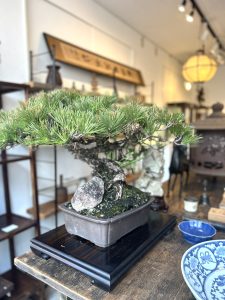線香花火の奥深さを知りました(愛知県名古屋市千種区姫池通 骨董買取 古美術風光舎)
2025.08.06

先日知ったのですが、最近の花火大会では点火がコンピューター制御されているところが増えているとのこと。昔と違い音楽に合わせた演出が増えたことも理由に挙げられています。打ち上げのタイミングを1/30秒単位でコントロールできる制御システムもあるのだとか。よく考えると手作業でそれらをコントロールするのは神業ともいえます。
コンピューターによる制御は一見効率的に思えますが、打ち上げるタイミングのプログラミングなど、準備には従来の花火大会の3倍の時間がかかるのだとか。確かに最近の花火はまるでミュージカルを見ているかのように感じることもあります。未だに職人が点火しているイメージを持っていた私はかなり時代に取り残されていたということでしょう。
夜空を彩る大輪の花火も魅力的ですが、日本人にとって夏の花火といえばやはり手持ち花火ではないでしょうか。海外では安全を考慮して手持ち花火が禁止されている国が多いそうです。そのため日本を旅行中に手持ち花火を楽しむ外国人も多いのだとか。特に線香花火は「Japanese Sparklers」とも呼ばれ日本ならではの伝統的な手持ち花火として知られています。
子供の頃、様々な手持ち花火を楽しんだ後、最後は線香花火で終わるというのが暗黙の了解でした。繊細な線香花火は静かに持っていないと火球が落ちてしまうため緊張して持つ手が震えることもあったような…。線香花火となると皆急に神妙な面持ちになったものですが、実際のところ誰が最後まで火球を落とさないか、と密かに競い合ってもいました。
線香花火は江戸時代に玩具花火として開発され、当初はワラの先端に火薬を付け、線香を立てる香炉などにさして楽しんだことから「線香花火」と呼ばれるようになったとか。その後関東ではワラの代わりに紙で作られうようになり、今でもその名残りで西日本では棒状、東日本では紙製の線香花火が多いとのこと。
次々と変化する火花は順番に「つぼみ」「牡丹」「松葉」「散り菊」、となんとも情緒あふれる呼び名がつけられています。
日本人ならこの名前を聞くと線香花火の火花が順番に浮かぶのではないでしょうか。私はてっきり、この順番で火花が散るように仕込まれているのだと思っていましたが、なんとこの火花が変化する原理は未だ完全には解明されていないのだそうです。研究者による様々な仮説があるようですが、難しい化学反応式が並び、私の理解の範囲を超えております。
かなり省略させていただきますと、線香花火に使われる黒色火薬の主成分である硝酸カリウム、炭素、硫黄が反応し、温度が約850℃にまで上昇すると火球が形成されます。さらに火球の表面にはCO2の気泡が多数あらわれ、これらがシャンパンの泡がはじけるようにパチパチと音を出しながら火花として飛び出します。実は火花というよりも「液滴」なのだそうです。そういえば子どもの頃、火球が丸く形成されていくのを見ていると、ゆらゆらと震える様子がまるでマグマのようだなと感じておりました。この繰り返し飛び散る液滴の軌跡が美しい火花として目に映っているのです。
これまで身近に楽しんでいたものが、こんなにも神秘のベールに包まれていたとは驚きです。
そんな日本伝統の花火ですが、低価格の外国産に押され一時は国産の線香花火づくりが途絶えた時期もあったのだとか。そこで東京の玩具問屋である山縣商店さんが、職人が一本一本手作業で作る国産線香花火を復活させています。少々高額ですが、その閃光を一度は見てみたいとういう衝動に駆られます。
ちなみに線香花火は呼吸しているため、時間を置くと硝石、硫黄、松煙がなじみ火花がより美しくなるのだそうです。使い残しの線香花火を見つけたら、試しに点火してみてはどうでしょうか。思いのほか美しい火花を見せてくれるかもしれません。
それでは、また次の機会に。(スタッフH)
I recently learned that more and more fireworks displays are now computer-controlled. One reason for this is that, unlike in the past, there are now more performances synchronized to music. There are even control systems that can control the timing of the launch to 1/30th of a second. When you think about it, controlling all of that by hand would be nothing short of a miracle.
While computer-controlled ignition may seem efficient at first glance, preparing for it—such as programming the launch timing—apparently takes three times as long as traditional fireworks festivals. Indeed, recent fireworks displays sometimes feel like watching a musical. I suppose I was quite behind the times, still holding onto the image of craftsmen manually igniting the fireworks.
While large fireworks that illuminate the night sky are also charming, for Japanese people, summer fireworks are still synonymous with handheld fireworks. Apparently, many countries overseas ban handheld fireworks for safety reasons. As a result, many foreign tourists enjoy handheld fireworks while traveling in Japan. In particular, incense stick fireworks are known as “Japanese Sparklers” and are recognized as a traditional Japanese handheld firework.
When I was a child, it was an unspoken rule that after enjoying various types of handheld fireworks, we would end with incense stick fireworks. The delicate incense stick fireworks had to be held quietly, or the fireball would fall, so my hands would tremble with tension. When it came to incense stick fireworks, everyone suddenly became solemn, but in reality, we were secretly competing to see who could keep the fireball from falling until the end.
Incense stick fireworks were developed as toy fireworks during the Edo period. Initially, gunpowder was attached to the tip of straw, which was then inserted into incense burners to enjoy the fireworks, hence the name “incense stick fireworks.” Later, in the Kanto region, paper replaced straw, and even today, this tradition continues, with stick-shaped incense stick fireworks being more common in western Japan and paper-made ones in eastern Japan.
The ever-changing sparks are named in order as “bud,” “peony,” “pine needles,” and “falling chrysanthemums,” evoking a sense of nostalgia.
If you’re Japanese, hearing these names might make you picture the sparks of incense stick fireworks in sequence. I had always assumed that the sparks were designed to scatter in that order, but apparently, the principle behind how the sparks change is still not fully understood. There are various hypotheses from researchers, but the complex chemical reactions involved are beyond my understanding.
To put it simply, the main components of black powder used in incense stick fireworks—potassium nitrate, carbon, and sulfur—react, causing the temperature to rise to approximately 850°C, forming a fireball. On the surface of the fireball, numerous CO2 bubbles appear, which pop like champagne bubbles, creating the sparkle. Interestingly, these are actually “droplets” rather than sparks. Come to think of it, when I was a child, watching the fireball form into a sphere, I felt that its trembling appearance was like magma. The repeated scattering of these droplets creates the beautiful sparks we see.
It’s surprising that something I’ve enjoyed so closely was shrouded in such mystery.
Such is the traditional Japanese firework, but at one point, domestic incense stick fireworks production came to a halt due to competition from low-cost foreign imports. However, Yamagata Shouten, a toy wholesaler in Tokyo, has revived domestically produced incense stick fireworks, which are handmade one by one by skilled craftsmen. Though they are somewhat expensive, the urge to witness their dazzling display is irresistible.
By the way, incense fireworks “breathe,” so over time, the potassium nitrate, sulfur, and pine soot blend together, making the sparks even more beautiful. Leftover incense fireworks might just surprise you with their stunning sparks.
That’s all for now. See you next time. (Staff H)
*******************
ご実家の整理やお片付けなどをされている方のご相談などが多くございます。
お片付けなどくれぐれもご無理のないようになさってくださいませ。
風光舎では古美術品や骨董品の他にも絵画や宝石、趣味のお品など様々なジャンルのものを買受しております。
お片付けをされていて、こういうものでもいいのかしらと迷われているものでも、どうぞお気軽にご相談下さいませ。
また風光舎は、出張買取も強化しております。ご近所はもちろん、愛知県内、岐阜県、三重県その他の県へも出張いたします。
まずは、お電話お待ちしております。
愛知県名古屋市千種区姫池通
骨董 買取【古美術 風光舎 名古屋店】
TEL052(734)8444
10:00-18:00 OPEN

